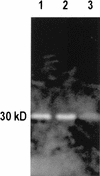Gram-negative bacteria produce membrane vesicles which are capable of killing other bacteria
- PMID: 9765585
- PMCID: PMC107602
- DOI: 10.1128/JB.180.20.5478-5483.1998
Gram-negative bacteria produce membrane vesicles which are capable of killing other bacteria
Abstract
Naturally produced membrane vesicles (MVs), isolated from 15 strains of gram-negative bacteria (Citrobacter, Enterobacter, Escherichia, Klebsiella, Morganella, Proteus, Salmonella, and Shigella strains), lysed many gram-positive (including Mycobacterium) and gram-negative cultures. Peptidoglycan zymograms suggested that MVs contained peptidoglycan hydrolases, and electron microscopy revealed that the murein sacculi were digested, confirming a previous modus operandi (J. L. Kadurugamuwa and T. J. Beveridge, J. Bacteriol. 174:2767-2774, 1996). MV-sensitive bacteria possessed A1alpha, A4alpha, A1gamma, A2alpha, and A4gamma peptidoglycan chemotypes, whereas A3alpha, A3beta, A3gamma, A4beta, B1alpha, and B1beta chemotypes were not affected. Pseudomonas aeruginosa PAO1 vesicles possessed the most lytic activity.
Figures




References
-
- Beveridge T J, Makin S A, Kadurugamuwa J L, Li Z S. Interactions between biofilms and the environment. FEMS Microbiol Rev. 1997;20:291–303. - PubMed
-
- Chatterjee S N, Das J. Electron microscopic observations on the excretion of cell-wall material by Vibrio cholerae. J Gen Microbiol. 1967;49:1–11. - PubMed
-
- Cleveland R F, Höltje J-V, Wicken A J, Tomasz A, Daneo-Moore L, Shockman G D. Inhibition of bacterial wall lysis by lipoteichoic acids and related compounds. Biochem Biophys Res Commun. 1975;67:1128–1135. - PubMed
Publication types
MeSH terms
Substances
LinkOut - more resources
Full Text Sources
Other Literature Sources
Molecular Biology Databases

